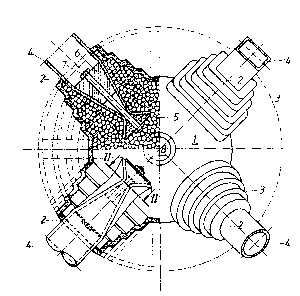Une partie des informations de ce site Web a été fournie par des sources externes. Le gouvernement du Canada n'assume aucune responsabilité concernant la précision, l'actualité ou la fiabilité des informations fournies par les sources externes. Les utilisateurs qui désirent employer cette information devraient consulter directement la source des informations. Le contenu fourni par les sources externes n'est pas assujetti aux exigences sur les langues officielles, la protection des renseignements personnels et l'accessibilité.
L'apparition de différences dans le texte et l'image des Revendications et de l'Abrégé dépend du moment auquel le document est publié. Les textes des Revendications et de l'Abrégé sont affichés :
| (12) Brevet: | (11) CA 1284265 |
|---|---|
| (21) Numéro de la demande: | 1284265 |
| (54) Titre français: | RACCORD SUR JOINT |
| (54) Titre anglais: | JOINT CONNECTION |
| Statut: | Périmé et au-delà du délai pour l’annulation |
| (51) Classification internationale des brevets (CIB): |
|
|---|---|
| (72) Inventeurs : |
|
| (73) Titulaires : |
|
| (71) Demandeurs : | |
| (74) Agent: | SMART & BIGGAR LP |
| (74) Co-agent: | |
| (45) Délivré: | 1991-05-21 |
| (22) Date de dépôt: | 1987-01-13 |
| Licence disponible: | S.O. |
| Cédé au domaine public: | S.O. |
| (25) Langue des documents déposés: | Anglais |
| Traité de coopération en matière de brevets (PCT): | Non |
|---|
| (30) Données de priorité de la demande: | ||||||
|---|---|---|---|---|---|---|
|
ABSTRACT
In a joint connection having a plurality of rods that
are combined to form a joint, the ends of the rods that protrude
through openings in a metal casing filled with hardenable filler
substance are necked down; in the necked down end section of each
rod there are two conical expander elements that can be tightened
against each other by means of a tension element, said expander
elements being under tension and situated on opposite sides of the
necked down portion of the rods.
Note : Les revendications sont présentées dans la langue officielle dans laquelle elles ont été soumises.
Note : Les descriptions sont présentées dans la langue officielle dans laquelle elles ont été soumises.

2024-08-01 : Dans le cadre de la transition vers les Brevets de nouvelle génération (BNG), la base de données sur les brevets canadiens (BDBC) contient désormais un Historique d'événement plus détaillé, qui reproduit le Journal des événements de notre nouvelle solution interne.
Veuillez noter que les événements débutant par « Inactive : » se réfèrent à des événements qui ne sont plus utilisés dans notre nouvelle solution interne.
Pour une meilleure compréhension de l'état de la demande ou brevet qui figure sur cette page, la rubrique Mise en garde , et les descriptions de Brevet , Historique d'événement , Taxes périodiques et Historique des paiements devraient être consultées.
| Description | Date |
|---|---|
| Inactive : Demande ad hoc documentée | 1994-05-21 |
| Le délai pour l'annulation est expiré | 1993-11-23 |
| Lettre envoyée | 1993-05-21 |
| Accordé par délivrance | 1991-05-21 |
Il n'y a pas d'historique d'abandonnement
Les titulaires actuels et antérieures au dossier sont affichés en ordre alphabétique.
| Titulaires actuels au dossier |
|---|
| "COMPROJECT" HANDELSVERTRETUNG UND TECHN. BURO FUR MASCHINENBAU FRANTL & CO. OHG |
| BEER, MANFRED |
| Titulaires antérieures au dossier |
|---|
| ALBERT P. RAUNICHER |
| ERICH FRANTL |
| PETER HOFSTATTER |
| WERNER FRANTL |
| WILLIBALD ZEMLER |